SRAM’s XX1 Eagle AXS mountain bike groupset is the brand’s most expensive, lightest weight, halo drivetrain developed on the cross-country racetrack.
SRAM says it's best-suited to XC riding, but is more than capable of performing in a wide range of trail-focused applications.
Shimano SRAM XX1 Eagle AXS groupset headline figures:
- Total weight (including 170mm cranks with 32t chainring, rear derailleur, 126 link chain, 10-52t cassette and shifter):1,533g
- Total price (including 170mm cranks with 32t chainring, rear derailleur, 126 link chain, 10-52t cassette and shifter):£1,958 / $1,949 / AU$2,783
As the range-topper in SRAM’s Eagle lineup, XX1 AXS gets plenty of top tech including wireless electronic shifting and compatibility with other AXS-enabled parts, such as the RockShox Reverb dropper post.
There’s titanium hardware and carbon fibre is used wherever possible in the derailleur and crankset. Impressive construction techniques are used to make the one-piece cassette, too.
Since the launch of XX1 Eagle AXS, SRAM has introduced GX Eagle AXS, a more affordable version of the halo 12-speed mountain bike drivetrain.
Out on the trail, XX1 Eagle AXS is one of the best performing drivetrains out there. Its shift quality remains unchanged regardless of weather conditions or how little it has been cared for. Despite the light weight of its components, it’s remarkably robust even when used beyond its XC-focused remit.
It is eye-wateringly expensive, though, and some on-power shifts could be smoother. The derailleur’s clutch tension could be increased, too.
SRAM’s X01 AXS might be better suited to burlier enduro-style riding and comes with a small weight penalty for the pleasure, but XX1 AXS currently has little to no competition from other brands, and if money is no object you shouldn’t be considering anything else.
SRAM XX1 Eagle AXS groupset details and specifications
I’ll run through the details of each of SRAM XX1 Eagle AXS’s components and the technology that is offered for the enormous price tag.
SRAM XX1 Eagle DUB SL crankset with SRAM XX1 Eagle 32t chainring specifications
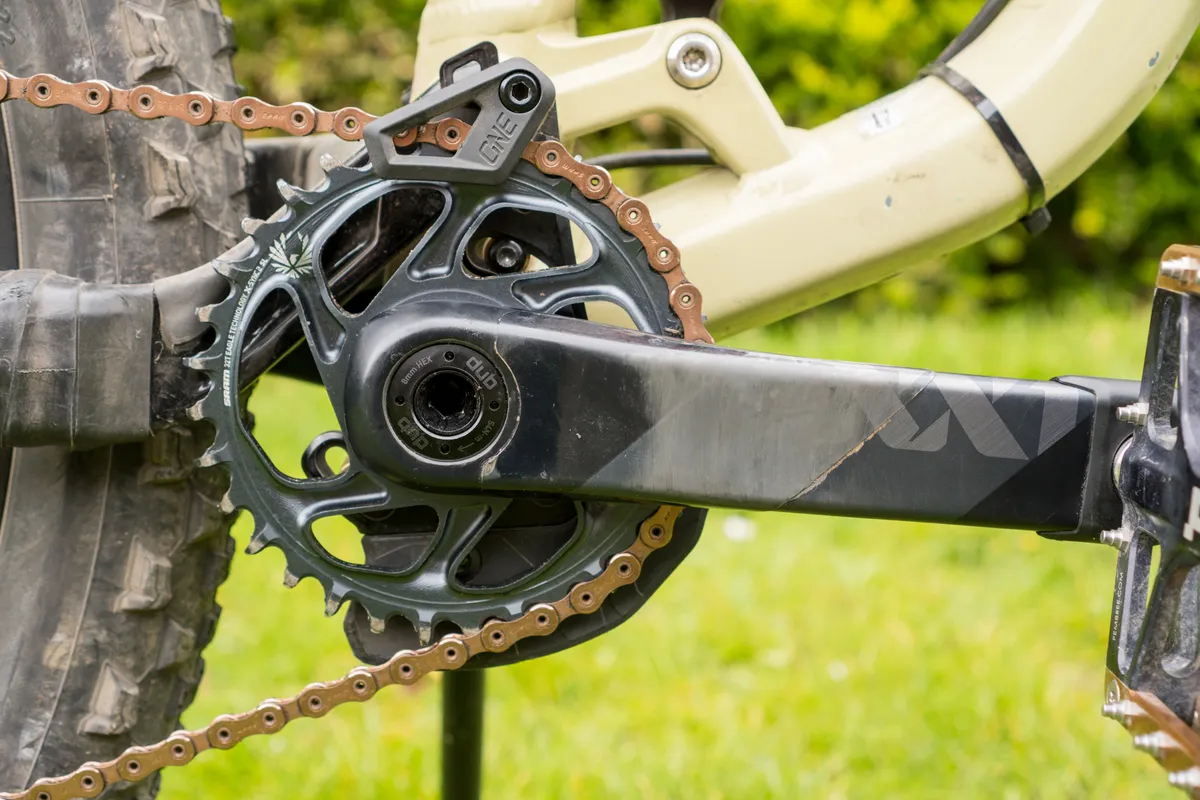
Like the rest of SRAM’s mountain bike cranks, the XX1 model uses its 28.99mm DUB bottom bracket axle that’s claimed to offer an excellent balance between weight, stiffness and strength.
The XX1 cranks are built from SRAM’s ‘Tuned’ carbon fibre that’s claimed to double down on the stiffness to weight ratio that SRAM claims is its best yet.
Thanks to a proprietary carbon lay-up, crank wall thickness is increased in high-load areas and then tapers down to reduced thicknesses where less material is required.
They’re fitted with boots that sit over the cranks’ ends and are secured in place once the pedals have been attached, to protect them from rock strikes and damage.

The aluminium X-Sync 2 chainring – that uses a narrow-wide tooth profile to help with chain retention in 1x setups – uses SRAM’s direct-mount system, attaching to the cranks using three Torx T25 bolts.
Although the super-light XX1 ring (59g, 32t) will probably be paired with XX1 cranks, the cranks are compatible with all SRAM X-Sync 2 rings.
The 170mm long XX1 Eagle DUB SL crankset with 32t chainring weighed 438g on my scales.
SRAM XX1 Eagle AXS controller/shifter lever specifications

Using an encrypted wireless network, the electronic XX1 Eagle AXS controller communicates with a paired derailleur shifting one, two, three, four or all of the gears with a single push of either of the shifter’s two main buttons.
The third ‘sprint button’ located on the rear of the shifter and activated by your index figure can also be configured to shift either high or low gears.
The buttons’ functions and number of shifts can be user-programmed using the AXS smartphone app. Users can change which one selects high or low gear shifts and the buttons can even be set up to operate a RockShox Reverb AXS dropper post.
An alternative shifter paddle is available called the Rocker Paddle. This can be bought as an aftermarket upgrade and simulates the layout of the paddles of a traditional, mechanical shifter.
The shifter is powered by a single CR2032 coin cell battery which SRAM claims provides up to two years of life before replacement.
The shifter is IPX7 waterproof-rated which means it can be submerged in 1m of water for up to 30 minutes. Finally, it is MatchMaker compatible, meaning it can be mounted to compatible brake levers.
The XX1 Eagle AXS controller/shifter lever with battery and bar clamp weighed 82g on my scales.
SRAM XX1 Eagle AXS rear derailleur specifications
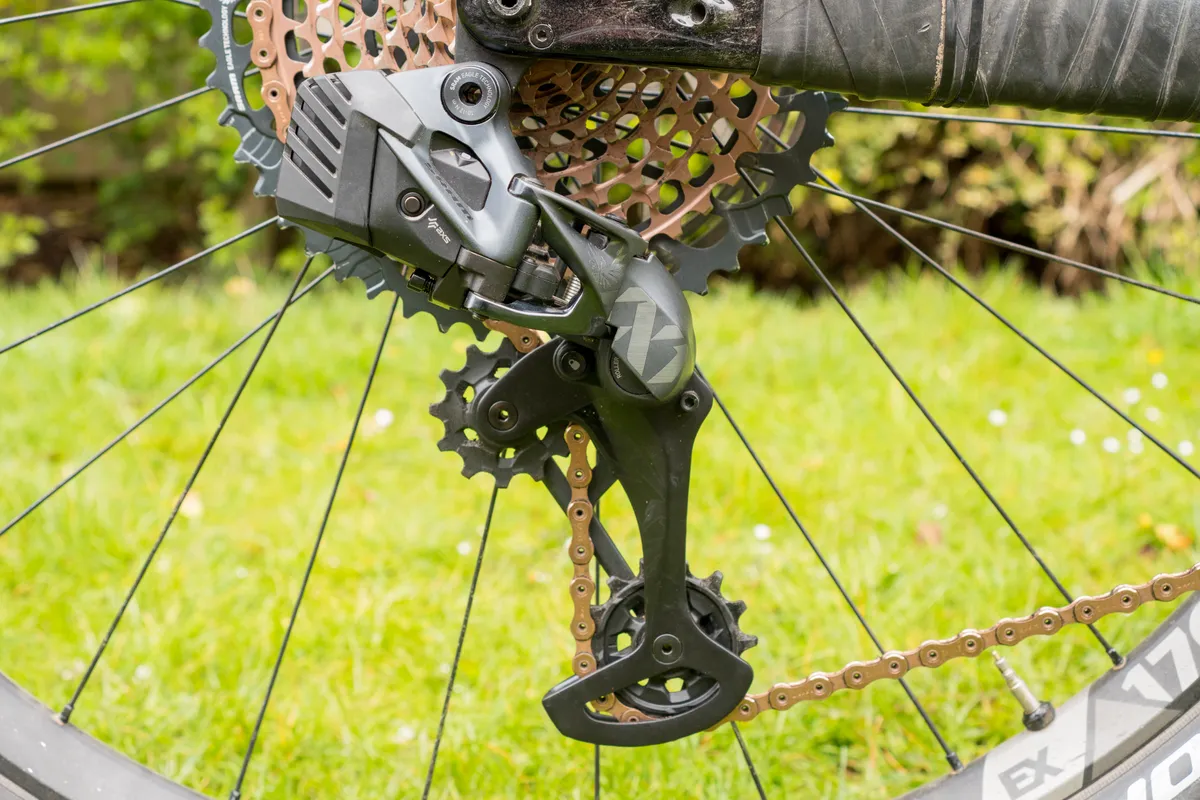
The XX1 Eagle AXS derailleur is built with an exotic mix of materials featuring a carbon fibre cage and titanium hardware.
The derailleur is IP69K dustproof and waterproof rated, which means it’s dust-tight and resistant to high-pressure, high-temperature washing. The removable and rechargeable onboard battery (that weighs 25g) has a claimed 20-hour between-charge lifespan.
It features two clutches. First is SRAM’s Type-3 Roller Bearing cage clutch that’s designed to improve chain stability and shift performance. To make wheel removal and installation easier, the cage can be locked forward using the Cage Lock button seen on the rest of SRAM’s 12-speed derailleurs.
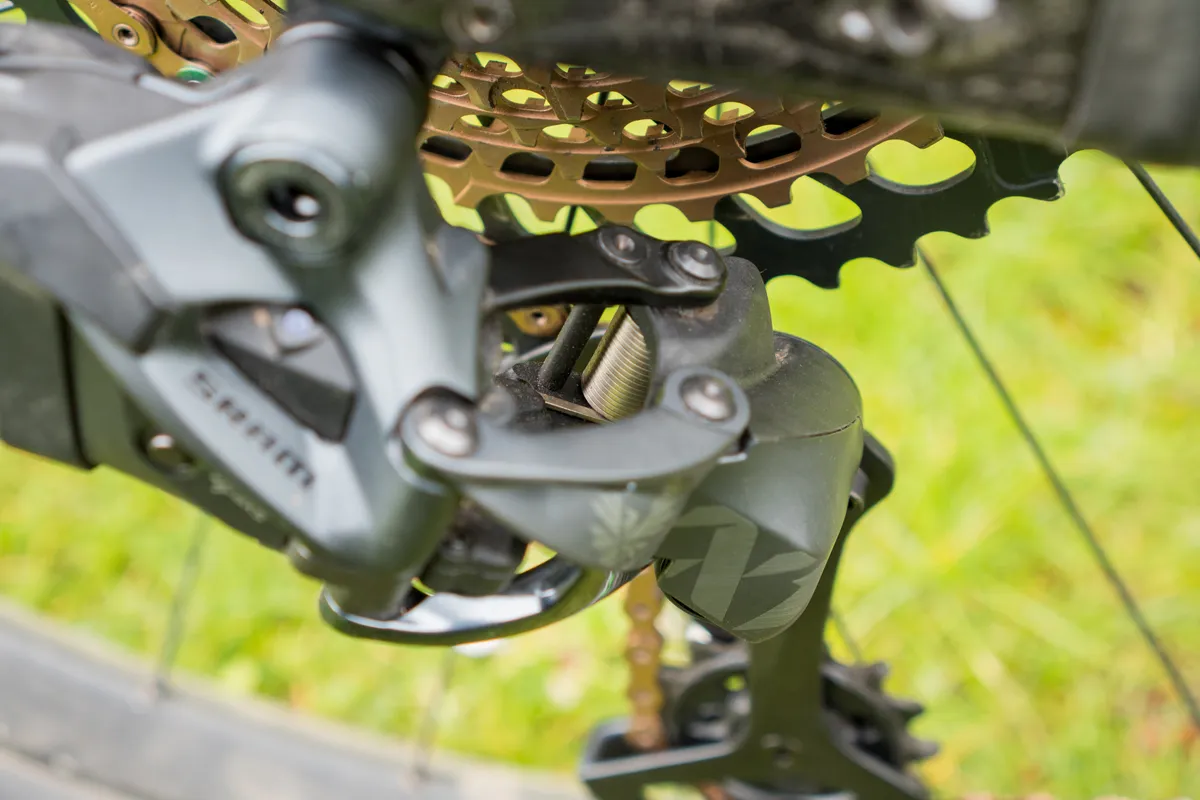
The second is the Overload Clutch that, in an impact, decouples the motor’s gearbox from the derailleur’s body to protect the two parts from damage. After the impact, the motor re-engages and resets the derailleur to its previous shift position.
The derailleur’s cage – as with the latest mechanical GX Eagle derailleur – is 10mm shorter than older models of the brand’s Eagle models. This also means it’s compatible with the latest 52t lowest sprocket cassettes and thanks to the cage’s canting, creates more cassette chain wrap. The jockey wheels run on sealed cartridge bearings, too.
When connected to the AXS app, the derailleur’s battery life is displayed and over-the-air updates can be made.
The XX1 Eagle AXS rear derailleur with battery weighed 377g on my scales.
SRAM XX1 Eagle 10-52t XG-1299 cassette and SRAM XX1 Eagle chain specifications

The 10-52t Eagle cassette uses SRAM’s X-DOME technology where the lowest 52t alloy sprocket is pinned to the other 11 cogs which are machined out of a single block of steel. This gives the cassette a lightweight, strong and mud-shedding open design.
It uses SRAM’s XD Driver freehub body and has X-Glide 2 tech that pairs with SRAM’s chains in a bid to create smooth on-power shifts.
The XX1 cassette shares the same ratios as the rest of SRAM’s 52t, 12-speed cassettes: they are 10t, 12t, 14t, 16t, 18t, 21t, 24t, 28t, 32t, 36t, 42t, and 52t.
The XX1 Eagle 10-52t XG-1299 cassette weighed 376g on my scales.
Matched with the XX1 cassette is the XX1 Eagle 12-speed chain.
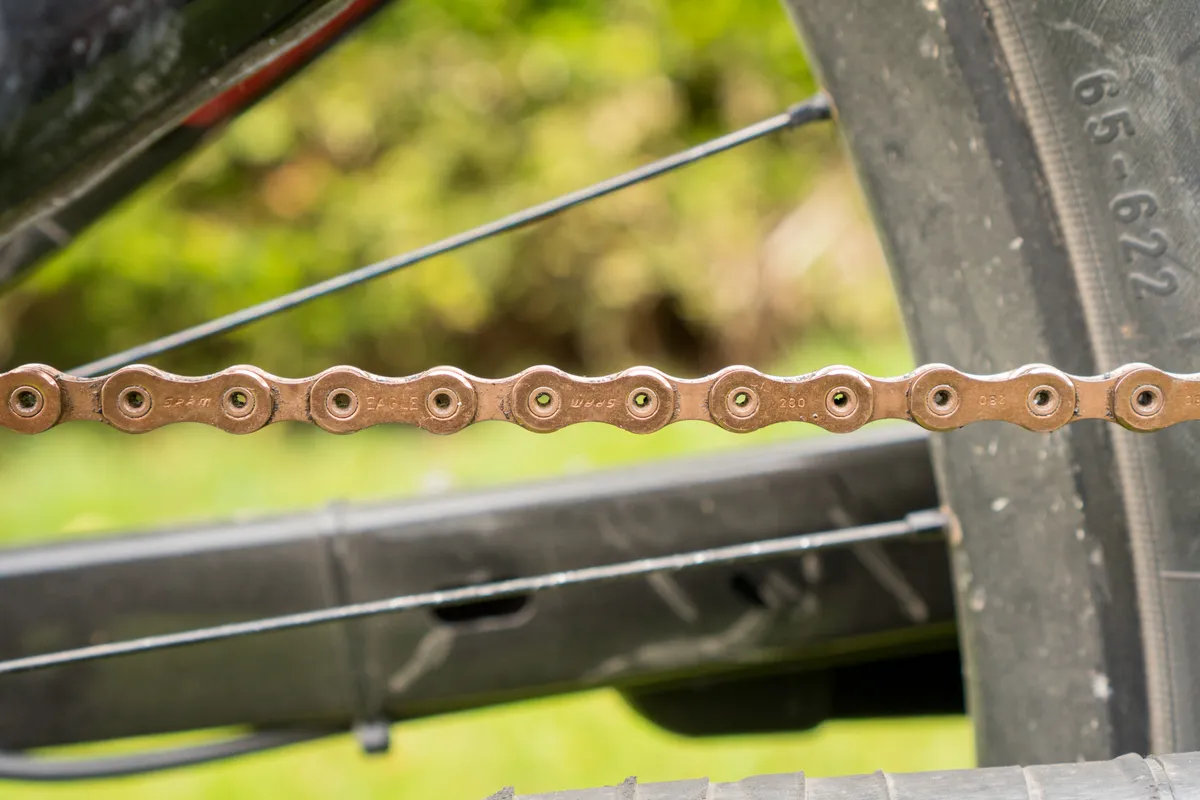
SRAM claims its XX1 chain has a groundbreaking new design and technology that contributes to top-tier performance.
In SRAM’s arsenal of chain tech is Flowlink, where the inner plates of the chain are completely smooth with no square edges, and Hard Chrome, which is a special finishing process on the inner links and rollers.
These two bits of tech claim to not only improve strength and reduce weight but also decrease friction and noise.
The chain’s pins are hollow and, like the rest of SRAM’s chains, it’s joined with a one-time use PowerLock connector.
The 126-link XX1 Eagle chain with PowerLock weighed 260g on my scales.
SRAM XX1 Eagle AXS groupset compatibility details
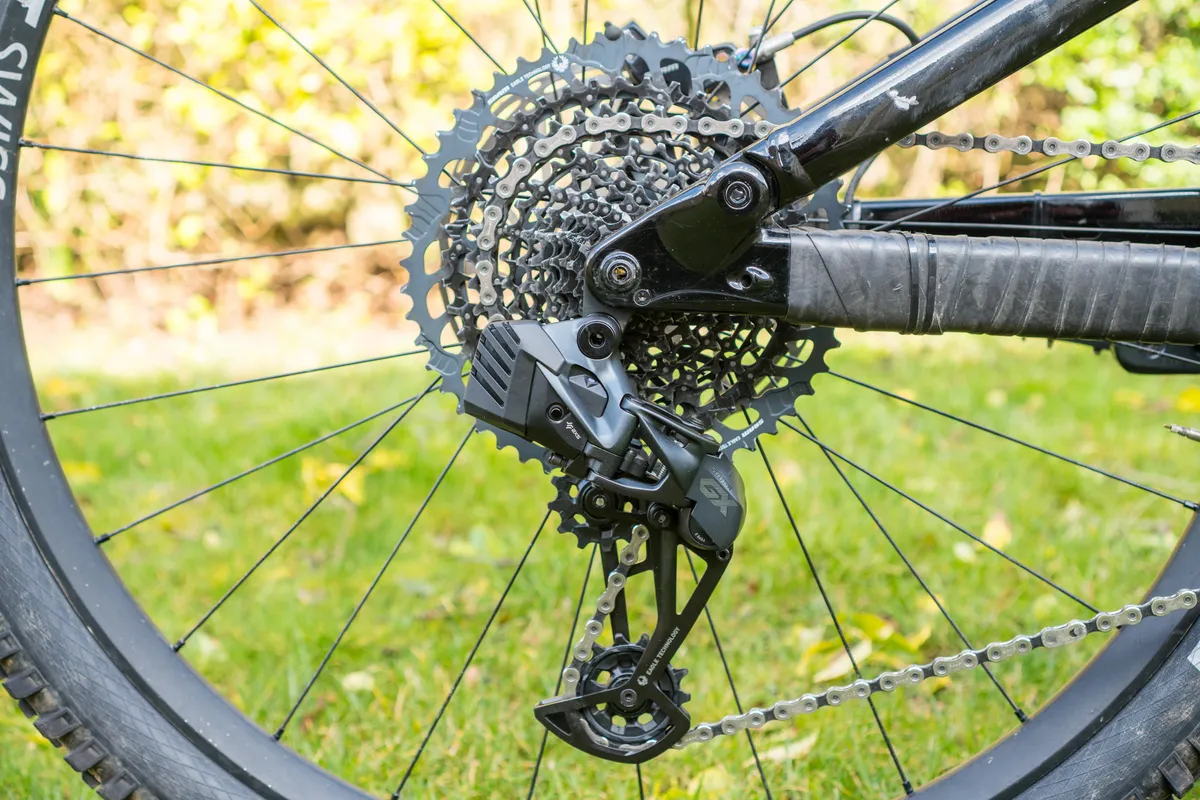
SRAM’s 12-speed Eagle ecosystem is almost totally inter-compatible. The XX1 Eagle AXS derailleur is compatible with all other SRAM Eagle cassettes (including the 11-50t, 12-speed SX and NX Eagle versions), chains, chainrings and cranks.
However, only GX Eagle, X01 Eagle and XX1 Eagle mechanical drivetrains are compatible with the 10-52t XX1 Eagle cassette.
XX1 Eagle AXS shifters and derailleurs are compatible with GX Eagle AXS and X01 Eagle AXS derailleurs and shifters, making mixing and matching possible. They’re also compatible with SRAM’s drop-bar RED eTap, Force eTap and Rival eTap AXS components.
SRAM doesn’t officially recommend mixing third-party components with its Eagle, claiming the best performance is achieved by keeping everything in-house.
However, because the AXS derailleurs are compatible with up to a 52t cassette sprocket, it would be feasible to match a SRAM XX1 Eagle AXS derailleur and shifter with Shimano 12-speed, 10-51t cassettes, chains and chainrings.
The cassette uses SRAM’s XD Driver, which means a specific freehub body is required. Make sure your hub is compatible with XD Driver freehubs or factor in the cost of an upgrade if you’d like to fit the XX1 Eagle cassette.
SRAM XX1 Eagle AXS groupset installation and setup
Installation methods for the top-level XX1 Eagle AXS groupset were the same as all levels of SRAM Eagle DUB bottom bracket groupsets.
The DUB bottom brackets require a special SRAM DUB bottom bracket tool for fitment or removal. Tools cost roughly £20 and are widely available, but if you’re coming from a Shimano Hollowtech bottom bracket, don’t expect your existing tool to work.
The crankset’s bottom bracket bearing preload lockring needs to be tightened as per SRAM’s instructions. This is a crucial step to avoid unwanted crank movement and bottom bracket bearing wear.
Care also needs to be taken to install the correct number of bottom bracket and crank axle spacers, but the guide on SRAM’s website is easy to follow.
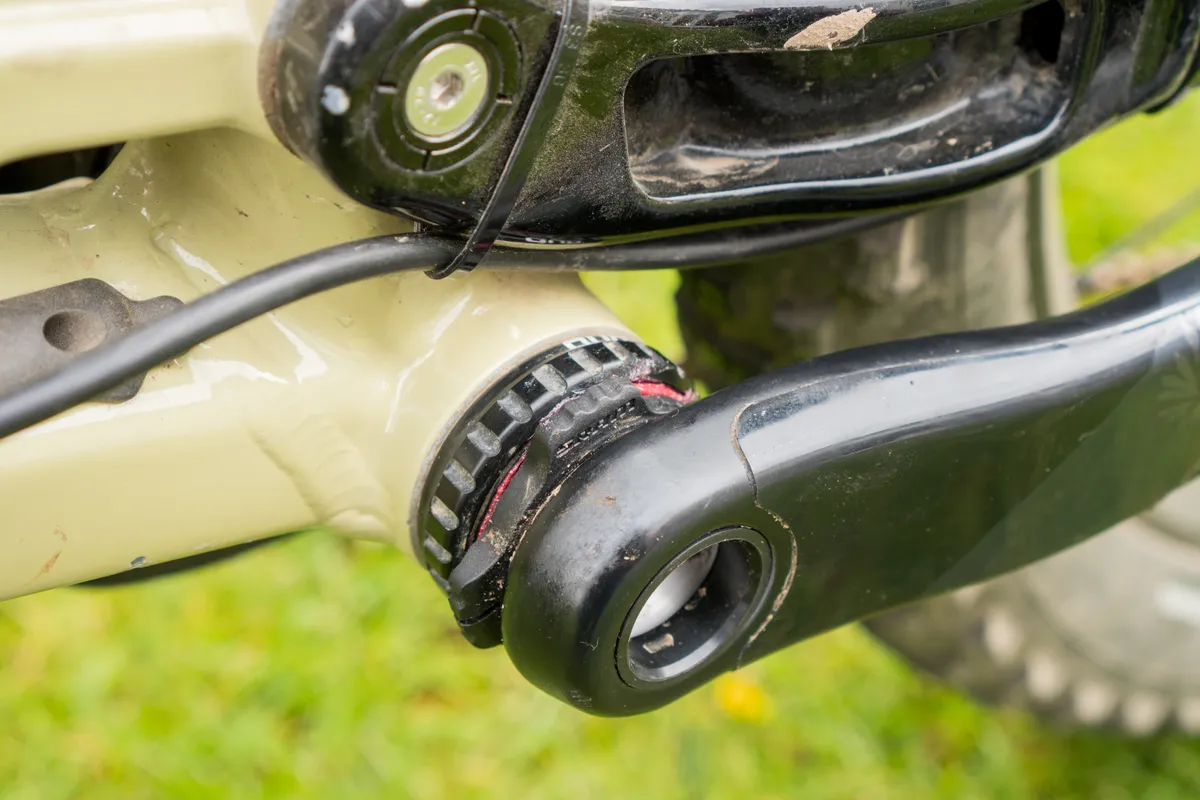
Thanks to the lack of gear cables, installing and connecting the derailleur and shifter is much easier than mechanical setups, especially on bikes with fiddly internally routed cables.
The shifter’s MatchMaker compatibility meant adjusting it to my preferred position was simple. Adjustment was also possible using the supplied bar clamp on bikes without MatchMaker -ompatible brakes. The shifter has two mounting positions as well.
Although the MatchMaker system isn’t officially compatible with Shimano’s I-Spec mounts, plenty of third-party adaptors are available.
To pair the shifter and derailleur, the AXS button – a third button on the shifter and the only button on the derailleur – needs to be pushed. Connecting the drivetrain to the smartphone AXS app was also simple thanks to on-screen instructions.

Once paired, it is impossible to ‘hijack’ a derailleur or shifter with an unpaired device unless the pairing is broken in the app (that’s also securely paired with the derailleur and shifter) and the AXS button is pushed again.
Just like all of SRAM’s Eagle derailleurs, setting the b-tension correctly is a crucial step to ensure spot-on shift performance. If the derailleur’s b-tension is set up incorrectly, shifting is lazy and clunky.
Although the setup procedure is simple in theory – where the suspension must be compressed to sag, the derailleur set in gear two of 12, and the b-tension gap tool (that’s supplied with the derailleur) used to set the correct amount of b-tension – in practice, it’s tricky to get it adjusted perfectly, especially for the less competent mechanic or if you’re working on the bike alone.
Chain length adjustment is another important step to guarantee performance and the right compromise between the chain being long enough for the suspension to bottom-out in the 52t sprocket without damaging the derailleur and not so long that it is loose in the 10t sprocket.
Like the b-tension adjustment, SRAM’s chain length adjustment instructions are simple in theory. For a full suspension bike, the suspension needs to be set at the point where the rear axle is the furthest away from the bottom bracket.
While on quite a few bikes this will be at bottom-out, that isn’t a fool-proof rule. For example, on bikes with a high pivot or rearward axle path, the point of maximum growth could be in the middle part of its travel.
To ensure correct set-up, this point will need to be measured carefully and then the bike’s suspension has to be fixed at this position during chain installation and length adjustment.
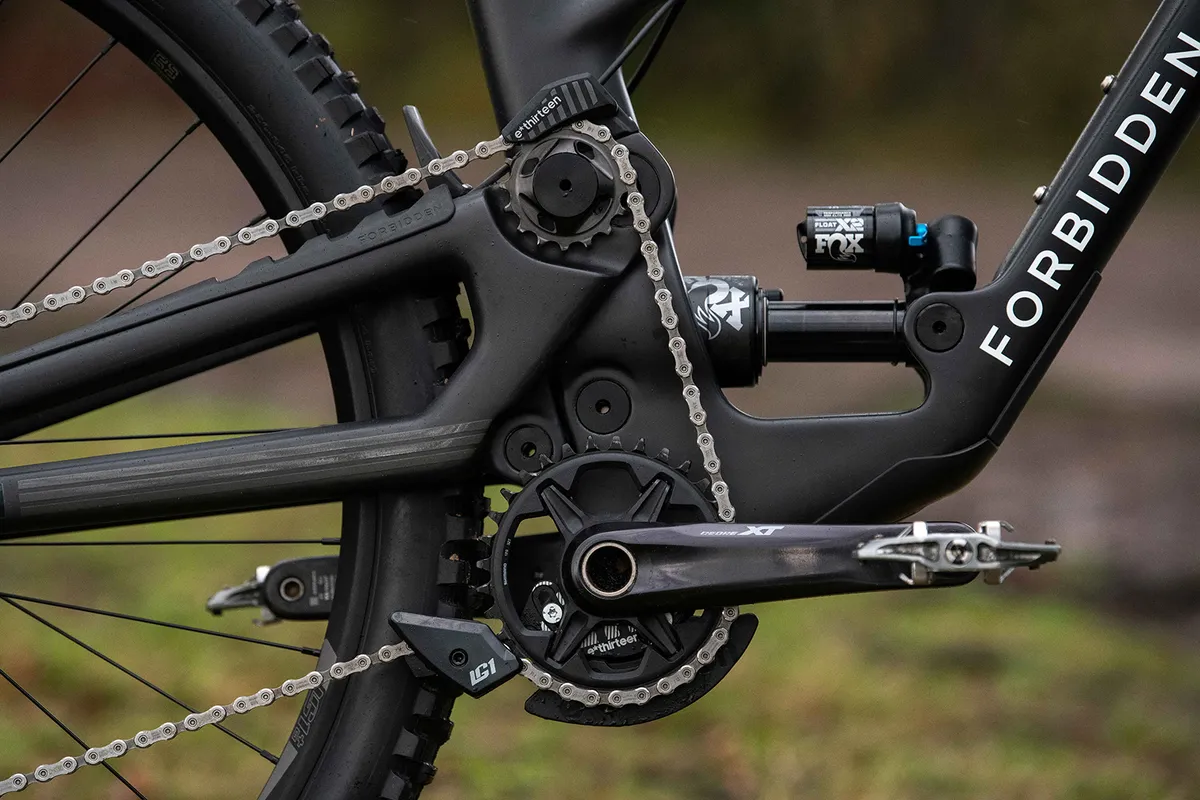
The chain then needs to be wrapped around the chainring and largest cassette sprocket, then one inner link and one outer link should be added from where the chain overlaps. The chain should then be sized correctly.
In reality, I found this made the chain too long and I needed to remove an additional inner and outer link on my bike even when the b-tension had been set correctly. It’s crucial that you take care to size your chain correctly because adding links back into a chain isn’t recommended.
SRAM says its PowerLink chain connector should only be used once. This is frustrating when trying to size the chain correctly, especially if you’ve spent upwards of £80 on a chain. In reality, the PowerLink can be used more than once but whether it retains its original strength isn’t guaranteed.
Finally, using SRAM’s micro-adjustment – where pushing the controller’s AXS button and either the low or high gear shift buttons performs minute derailleur adjustments that are the equivalent to adjusting cable tension on a traditional setup – the derailleur needs to be trimmed.
These are quick and easy to perform and can even be done on the move. The AXS app displays which of the 31 positions of micro-adjustment the derailleur is currently set at.
SRAM XX1 Eagle AXS groupset performance

I’ve been testing SRAM’s XX1 Eagle AXS groupset on my Marin Alpine Trail XR and on Specialized’s 2022 Turbo Levo, racking up in excess of 900km in Scotland’s Tweed valley, home to the UK’s round of the Enduro World Series and legendary 7Stanes trail network.
Testing took place over the course of several hard, winter months and, more recently, in dry, dusty, summery conditions.
Although XX1 is an XC-focused groupset and I’ve been testing it accordingly, I’ve also pushed it to its limits on rougher, more gnarly terrain, especially when riding the Turbo Levo.
SRAM XX1 Eagle AXS rear derailleur performance

The immediate and precise nature of each of the XX1 Eagle AXS derailleur’s shifts is enormously impressive. The derailleur doesn’t falter, strain or hesitate when subjected to multiple on-power shifts up or down the cassette and each push of the controller’s button is met with a predictable and corresponding change in gears.
The disconnection between the controller and derailleur meant that no matter how muddy, used or uncared for the derailleur was, it still performed as new time and time again.
This decoupling is most important when shifting on power; no extra force is required to change gears and there is no delay between the button being pushed and the derailleur moving.
Frequently on mechanical systems, you can feel the additional pressure required to operate the shifter lever when changing gear this way.
The derailleur is completely maintenance-free. Of course, it needs to be cleaned regularly, but once set up correctly I didn’t need to perform any routine adjustments or preventative maintenance.
The derailleur is also massively robust, despite SRAM’s claims that it’s got an XC-biased design.

The knuckle (its widest point) has received plenty of rock strikes and bashes, and the bottom edge of the carbon fibre cage has been ploughed through the ground on the inside of numerous right-hand turns.
Although cosmetic damage is clearly visible, none of the knocks or bashes have compromised the derailleur’s performance or its structural integrity. The cage’s carbon hasn’t splintered or cracked and neither has it bent.
The derailleur has remained true and straight, too. And the Overload Clutch proved to be a vital asset when I crashed on a sizeable right-hand hip jump, the bike crashing to the floor driveside first.
When I picked the bike back up, I heard the derailleur auto-right itself back to the last-selected gear without any damage or readjustments required.
Thanks to the lack of physical connection between shifter and derailleur, the clutch doesn’t interfere with how shifts feel and they remain light.
However, the clutch wasn’t as powerful as I wanted and chainslap wasn’t as well controlled as it could be. Although the chain didn’t drop down from the selected gear when freewheeling or pedalling over rough ground, there was more chainslap noise compared to any of Shimano’s 12-speed clutch derailleurs on the same bike.
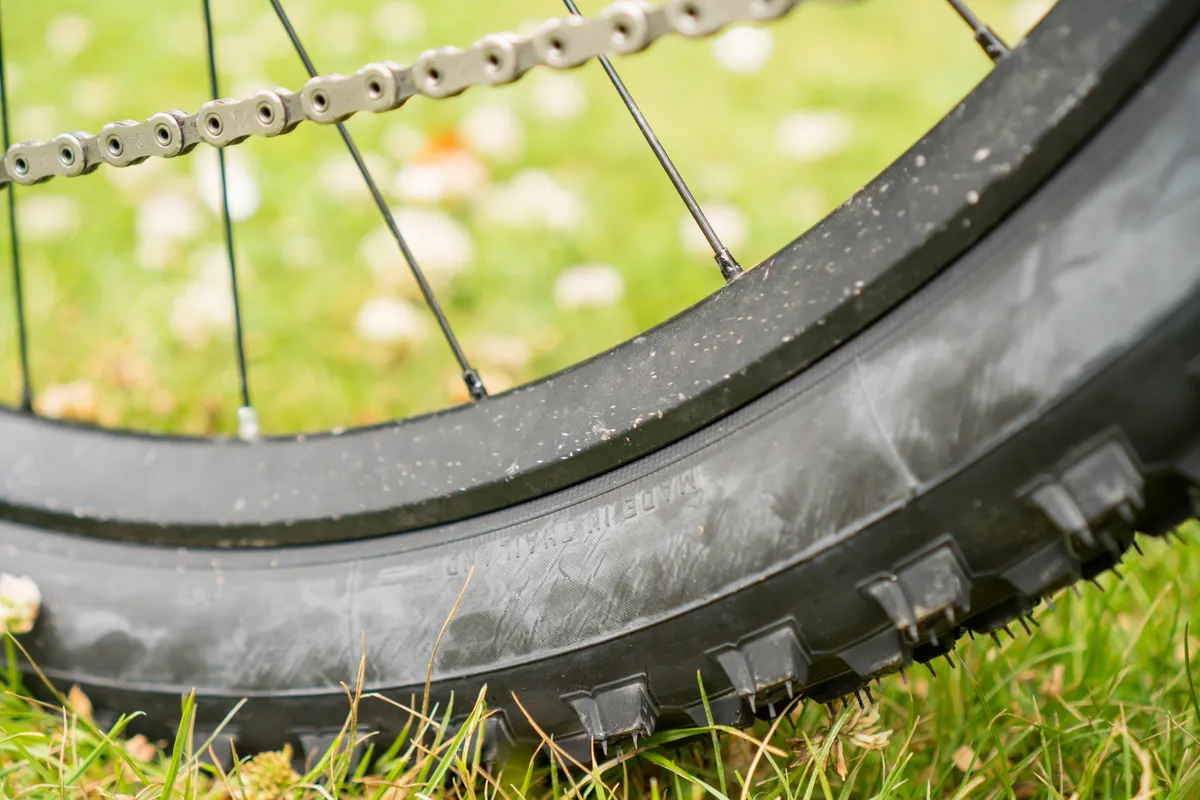
This is a shame because the clutch would benefit from being tighter from the factory or having user adjustability. I found this to be a consistent problem across all of SRAM’s Type-3 clutches on AXS and mechanical derailleurs because they all have the same tension.
The biggest issue created by the clutch’s low strength was the chain flicking against the driveside spokes and rim walls on my Marin Alpine Trail XR. While the rim only suffered cosmetic damage, after prolonged use I suspect the chain’s movement contributed to snapping one of the wheel’s spokes. The bike was also quite noisy over rough terrain.
On the Specialized Turbo Levo – thanks to its inbuilt chainstay protection – chainslap wasn’t as loud as the Marin, but there is still some visible damage on the side of the rim, hinting that the chain is moving just as much despite a decrease in noise.
Increasing clutch tension to improve chain control could have a negative effect on the suspension’s performance, stiffening it up. Given the XX1 AXS’s clutch isn’t adjustable, it’s only possible to speculate on whether or not there would be a negative impact, but I still believe an increase in clutch tension would have a net benefit.
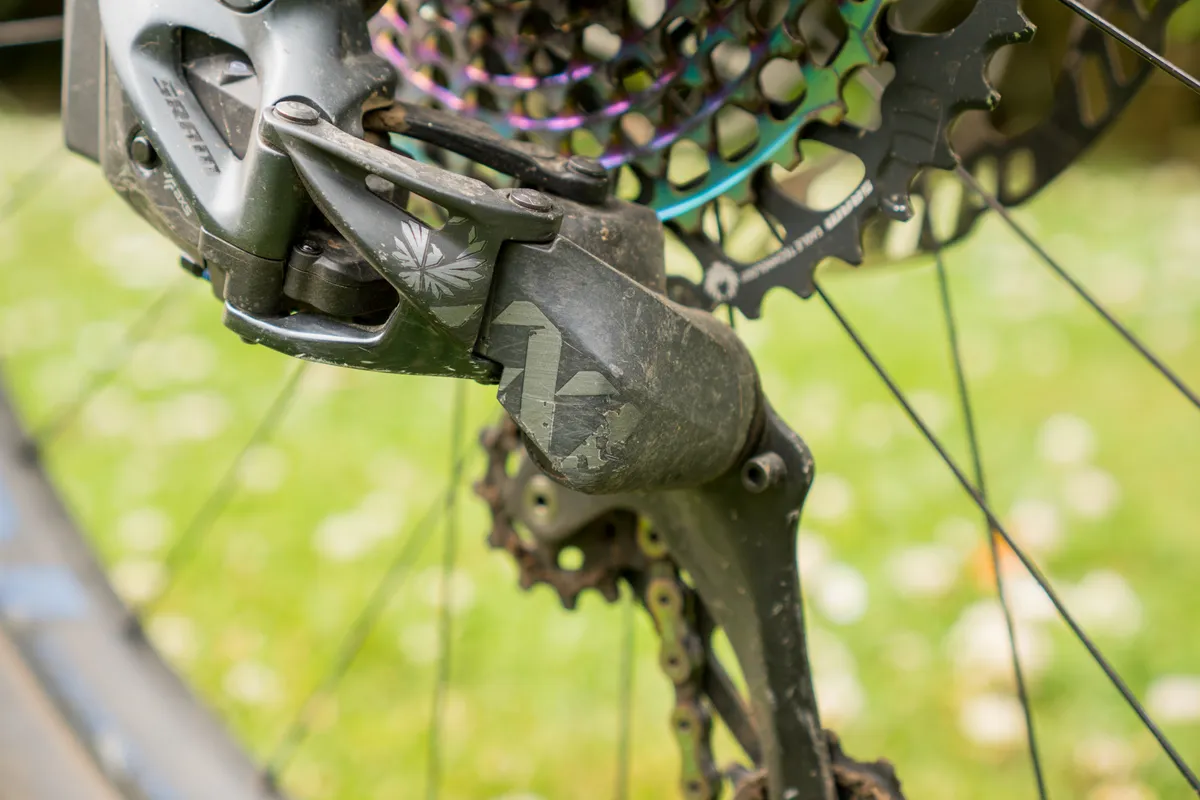
Shifting under power can be clunky or slow, especially at lower speeds or cadences such as in a low gear or grinding away in a higher one. This isn’t a problem caused by the derailleur’s functionality but appears to be related to shifting gear just after one of the cassette’s shifting ramps has passed the derailleur. The shift only happens when the next shift ramp passes the derailleur and the gear then changes.
At higher cadences or speeds this appears to be less of a problem and general on-power shifting is impressive. Arguably, the SRAM Eagle eco-system doesn’t have as good on-power shifting as Shimano’s 12-speed drivetrains.
Battery life was impressive and SRAM’s claims of 20 hours felt about right. Charging isn’t onerous and takes around an hour. For the charge-conscious, because it only weighs 25g and costs £50, carrying or buying a secondary battery isn’t prohibitive when you take into account the overall cost of XX1 AXS.
I never once ran out of charge though, despite frequently forgetting to charge the derailleur’s battery for weeks at a time.
SRAM XX1 Eagle AXS controller/shifter lever performance

Although the AXS controller’s buttons took a small amount of time to get used to – where the upper section was set to change to a higher gear and the lower section to a lower gear – once I’d become accustomed to its functionality, operation was second nature. As already mentioned, it’s possible to reprogramme the shifter button functions to suit your tastes.
The MatchMaker system placed the controller in my preferred position and the two fitment options meant there was plenty of side-to-side adjustment for the bar clamp version.
Shape-wise, the controller’s buttons felt spot on and I never found myself searching for them or missing in scenarios where an immediate shift was required.
Unlike some mechanical shifters – such as Box Components' Box One drivetrain – I didn’t need to stretch to push them and the lack of physical travel meant my thumbs remained closer to the grips, helping to improve control.
The buttons have a definitive click but are light to use. However, if you like your shifters close or touching your thumb, it’s easy to accidentally shift gears over rough terrain.

One of our testers sometimes struggled with the light shifter feel in the depths of winter when, on colder days, their thumbs were numb. They found there wasn’t quite enough feedback through the paddles and tended to shift too many times or not engage the shifter at all.
The consistency of the way they feel is impressive and guaranteed shift performance is a real perk of AXS. Because of the lack of cable between the derailleur and shifter, shifter feel doesn’t change or degrade over time.
SRAM XX1 Eagle cassette and SRAM XX1 Eagle chain performance
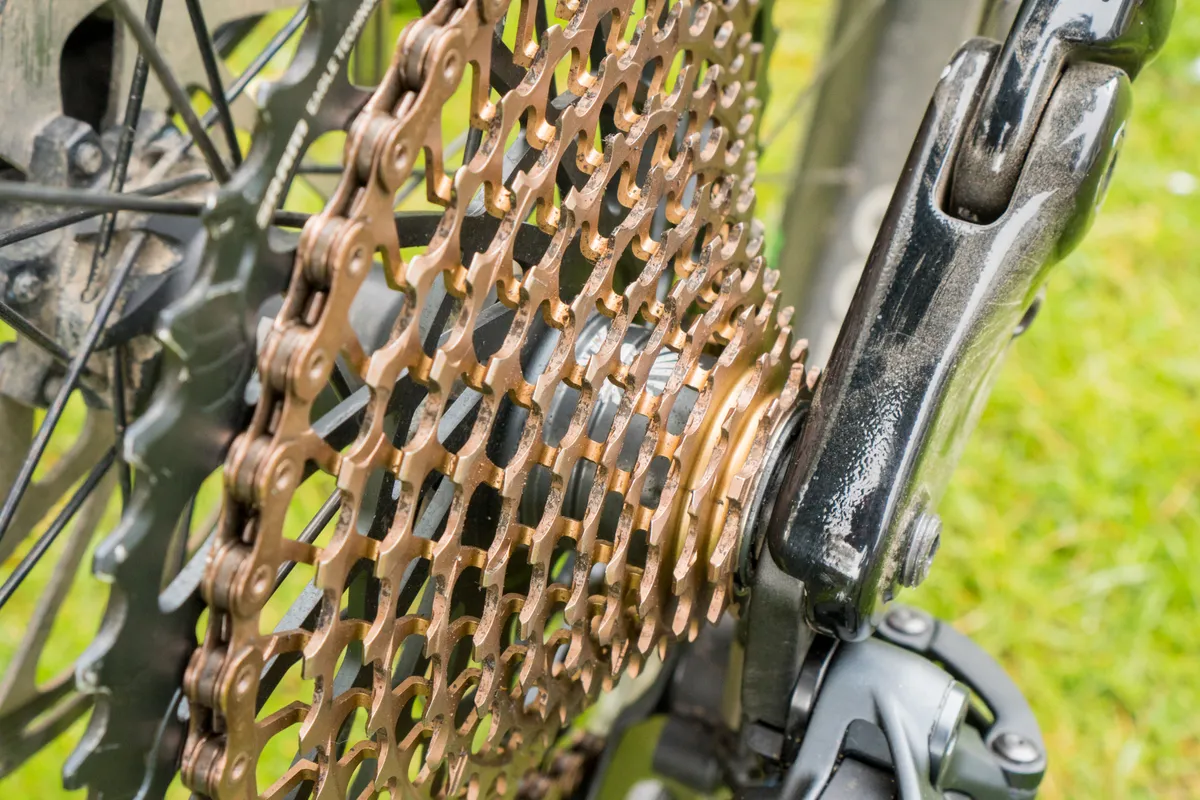
Given the enormous cost of the XX1 Eagle cassette (£408) and chain (£80), it’s a good job they’ve proven to not only be immensely light but also massively robust.
The copper colourway of my test sample cassette and chain – while receiving some fun-poking comments about its rusty looks – has remained mark- and wear-free, with no teeth hooking or the finish degrading. The same can be said for the rainbow finish on the other set of XX1 Eagle kit I’ve been testing.
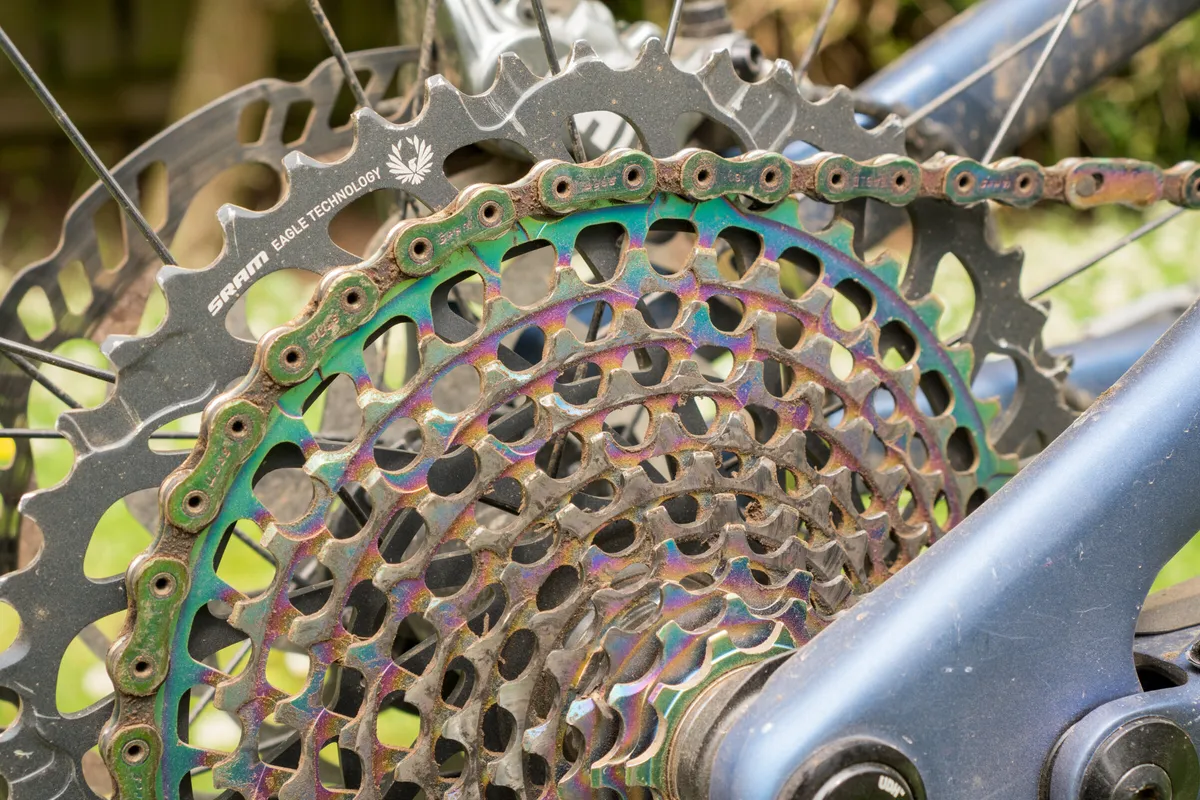
Under normal pedalling conditions the chain and cassette are impressively quiet. There’s no sneezing or grinding – as long as the derailleur is trimmed correctly – and the chain doesn’t jump up or down the cassette when on-power over rough ground.
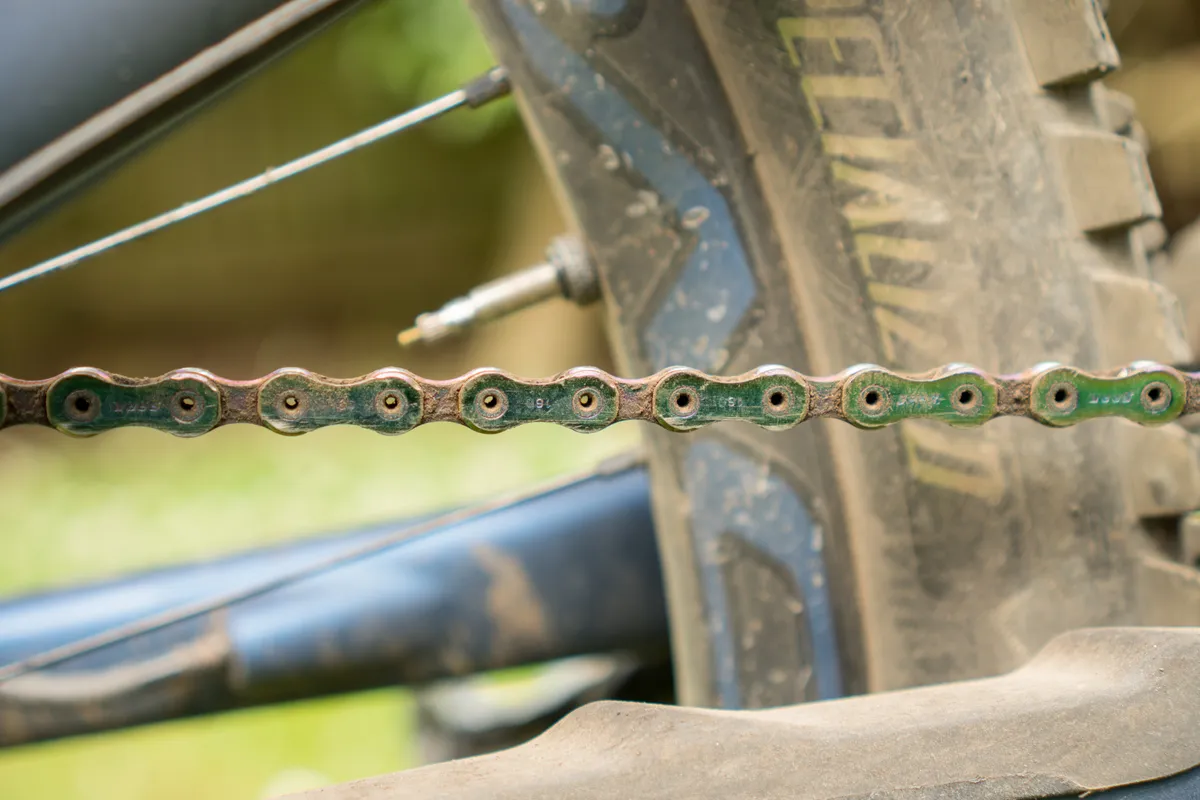
Shifting under high loads can be quite noisy, especially if you miss a shift ramp as it passes the derailleur. There were no miss-shifts, where the chain refused to shift altogether, but sometimes they were slow.
This didn’t negatively affect my ability to tackle climbs or damage any part of the drivetrain but did cause some raised eyebrows thanks to the noise made by the system.
Arguably, it’s not as smooth as Shimano HyperGlide+ cassettes and chains when shifting under power.
As I’ve mentioned in other SRAM Eagle drivetrain reviews, I find the jump between the 42t and 52t cassette sprocket uncomfortably large. The same problem is present on the XX1 Eagle cassette. Changing between these two gears requires a change in cadence or speed that’s bigger than, in my opinion, it should be.
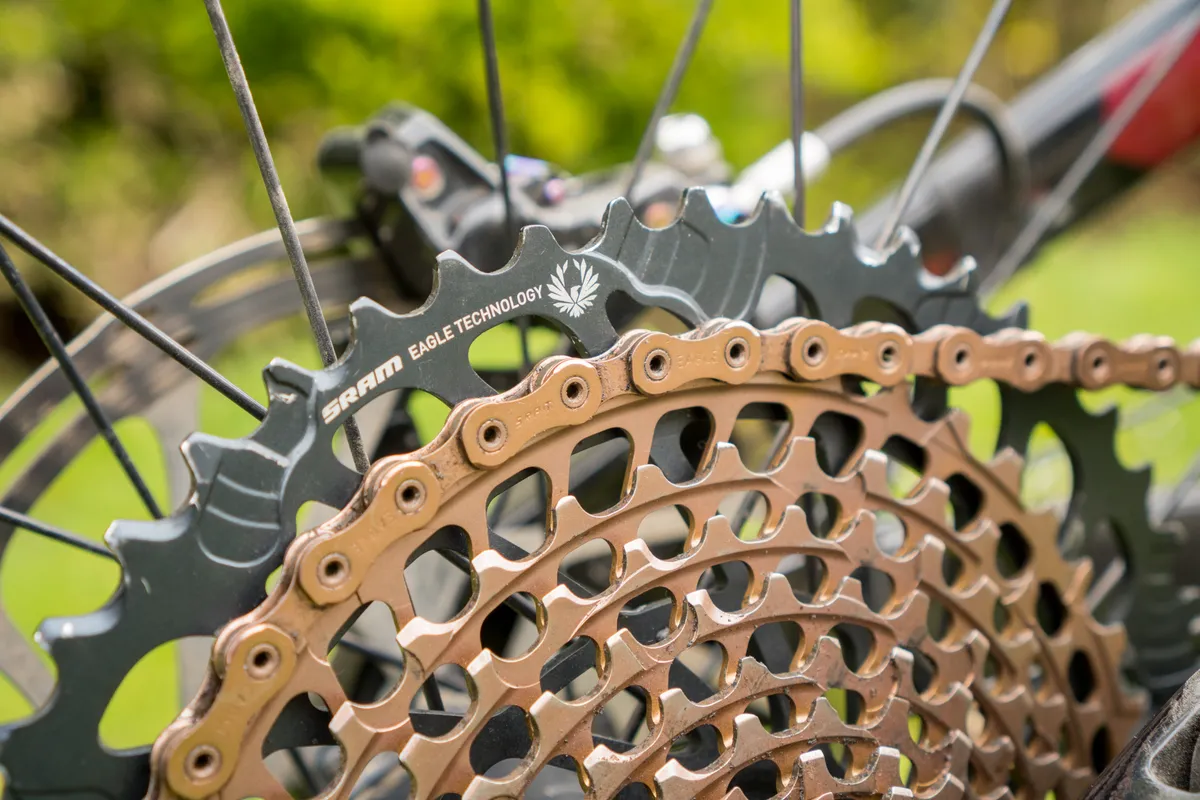
A solution could be to increase the number of teeth of the 42t sprocket to reduce the jump to the 52t.
However, when run with a 30t chainring, I found myself using the 52t sprocket way less than I did with a bigger chainring, reserving that largest cog for the slowest-speed, hardest climbs, using it as a true bailout gear – arguably the function SRAM designed it for. This proved to be an acceptable solution to mitigate the jumps between the cassette’s gear ratios.
There’s no denying how light and well-built the XX1 cassette is, reducing unsprung mass and helping contribute to improved suspension performance.
If outright weight-saving performance is your objective – and you’re a fan of the Eagle ecosystem – the XX1 cassette should be on your must-buy list.
SRAM XX1 Eagle DUB SL crankset with SRAM XX1 Eagle 32t chainring performance
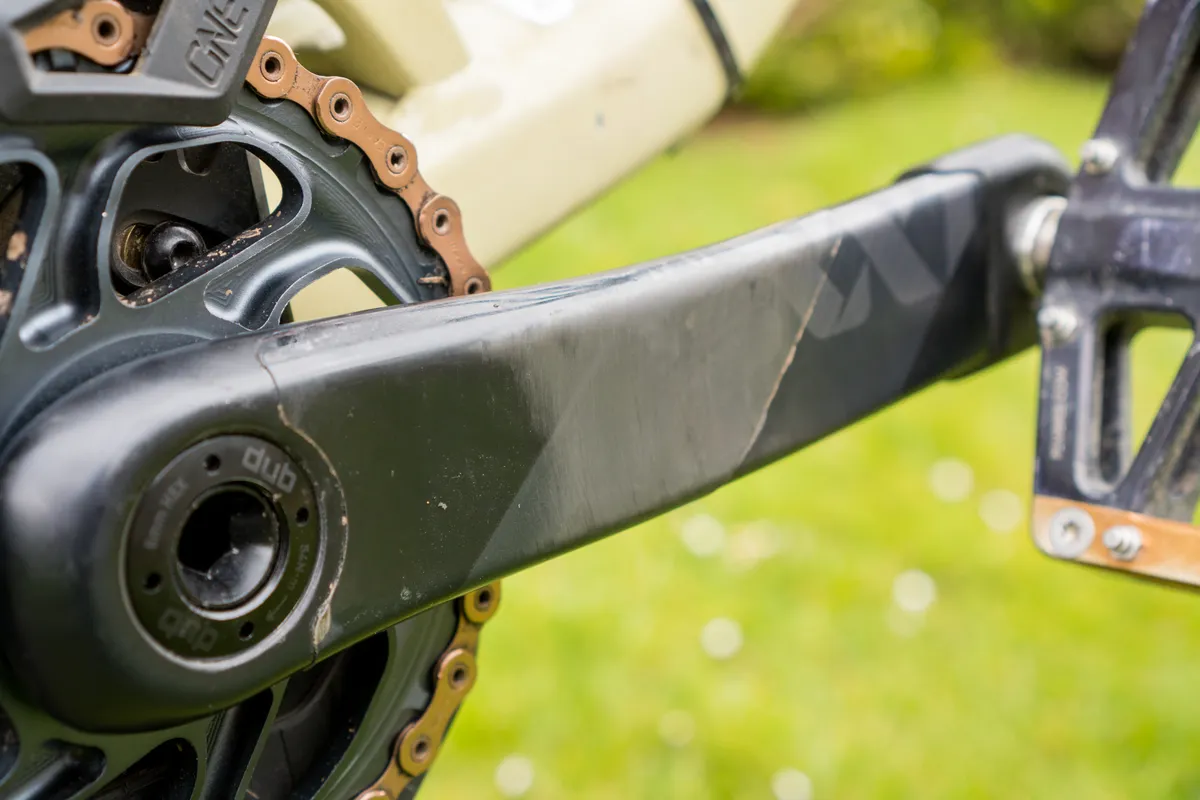
Like every crankset I’ve tested, I managed to scuff the finish on the face of the XX1 Eagle DUB SL crankset within one ride and began to wear it after two to three rides.
The XX1 cranks are delivered with a patch of clear 3M tape covering the section most prone to wear, but it only took a few rides before the tape became dog-eared and started to unstick.
Protecting the carbon fibre construction of the cranks is crucial, and the supplied boots do a good job of reducing damage on their ends.
Factory-fitting tougher-wearing 3M tape that’s wrapped around the crank would be a good improvement.
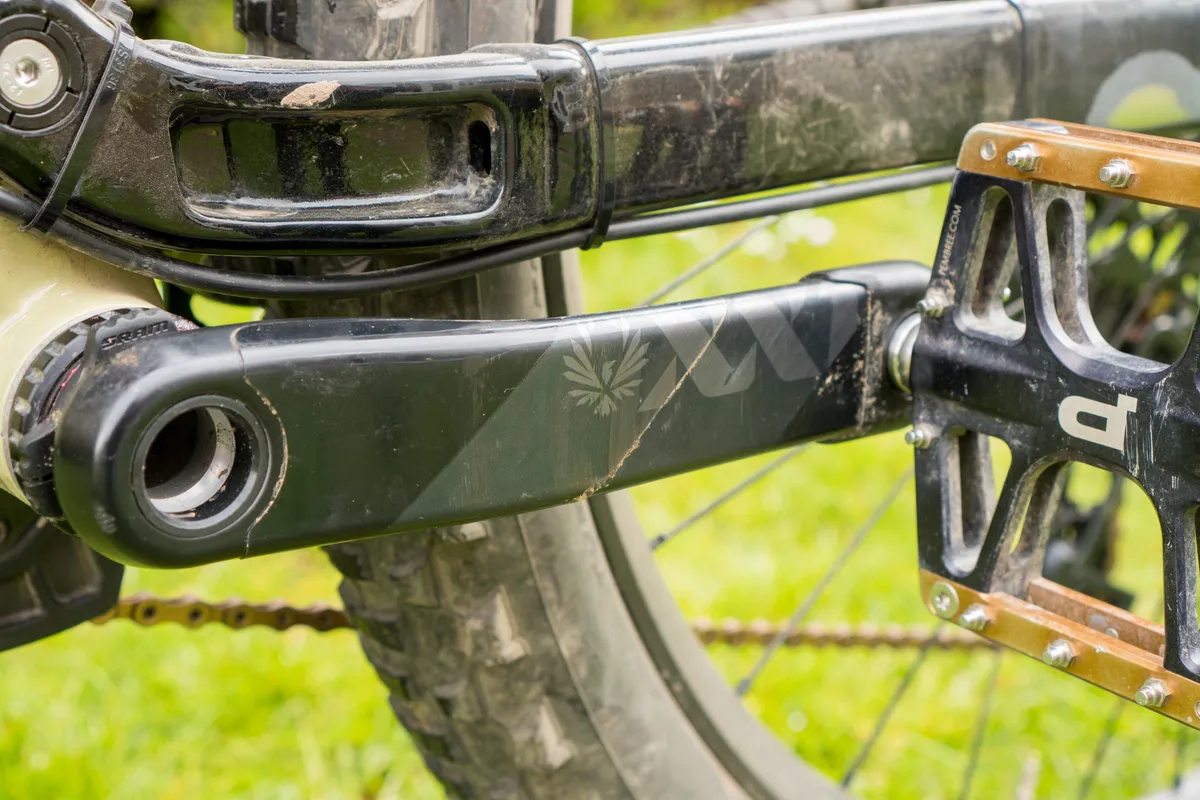
SPD riders are less likely to suffer from excessive crank wear as flat pedal riders, and the XX1 cranks – which are targeted quite specifically at XC riders – are less likely to be used by flat pedal riders anyway.
Despite the XC-bias and impressive 379g weight of the XX1 cranks, I didn’t notice any on-power flex. They also felt robust when being used for a short stint on enduro-style downhill trails, but this isn’t the recommended use for these cranks.
If you’re after SRAM’s lightest carbon fibre enduro cranks, the X01 version is better-suited.
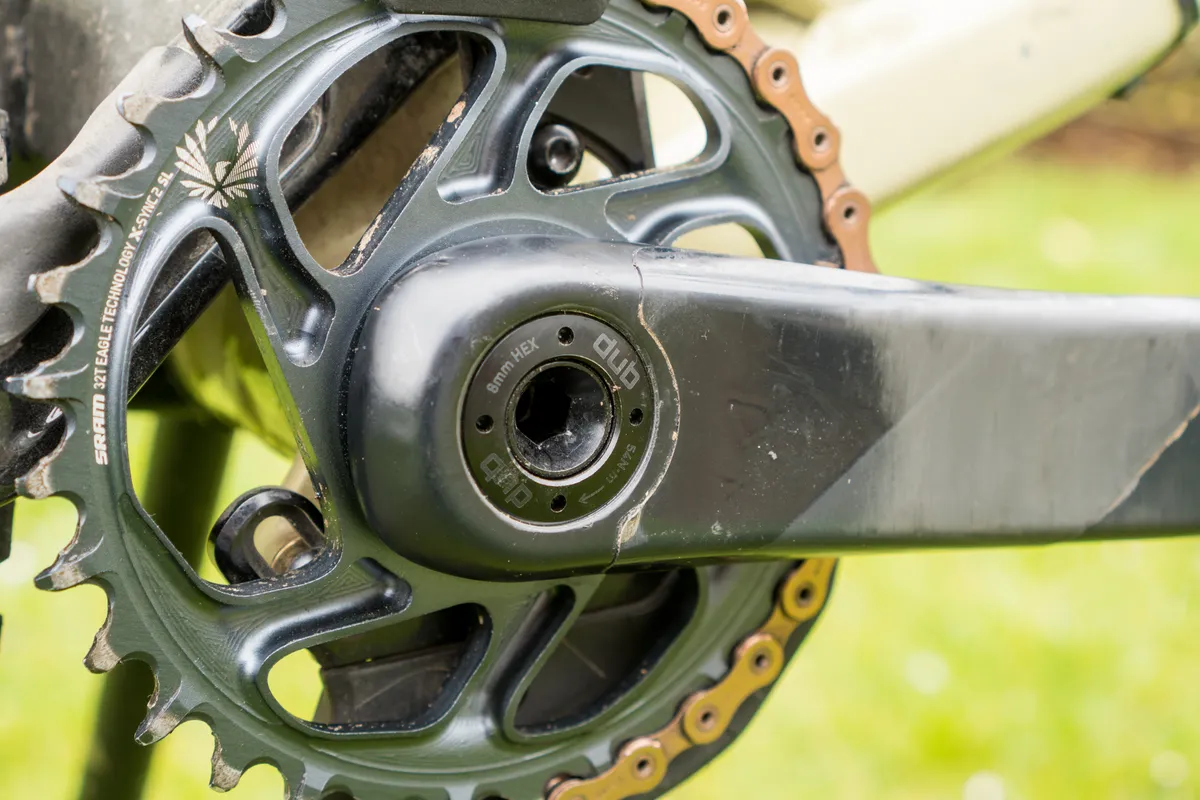
The plastic bearing preload locking rings are prone to coming loose on SRAM DUB cranks and the small 2mm Allen bolt that keeps them in place can strip the threads in the lockring when tightened. I didn’t experience this problem on XX1 cranks, but the design is the same as cranks where I have had to habitually tighten the lockring.
For riders looking for some of the lightest weight cranks on the market, the XX1 Eagle DUB SLs are hard to beat.
How does SRAM XX1 Eagle AXS compare to SRAM GX Eagle AXS and Shimano XTR M9100?
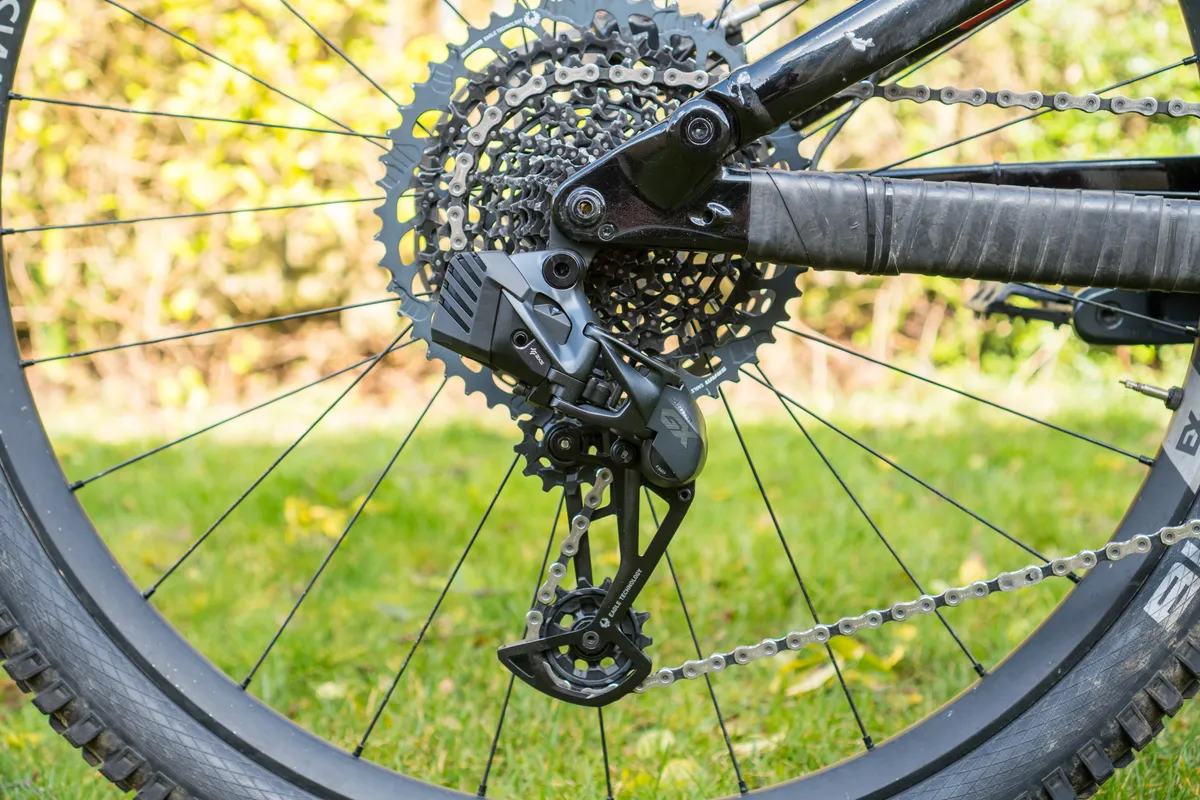
The £1,958 / $1,949 / AU$2,783 price tag makes the XX1 Eagle AXS groupset the most expensive mainstream drivetrain money can buy. And it’s currently peerless.
Shimano’s XTR M9050 Di2 groupset is now long in the tooth, first launched in 2014. And it’s hardly fair comparing XX1 Eagle AXS with XTR Di2 because M9050 is 11-speed not 12, and relies on cables to connect the shifter and derailleur rather than SRAM’s slick wireless setup.
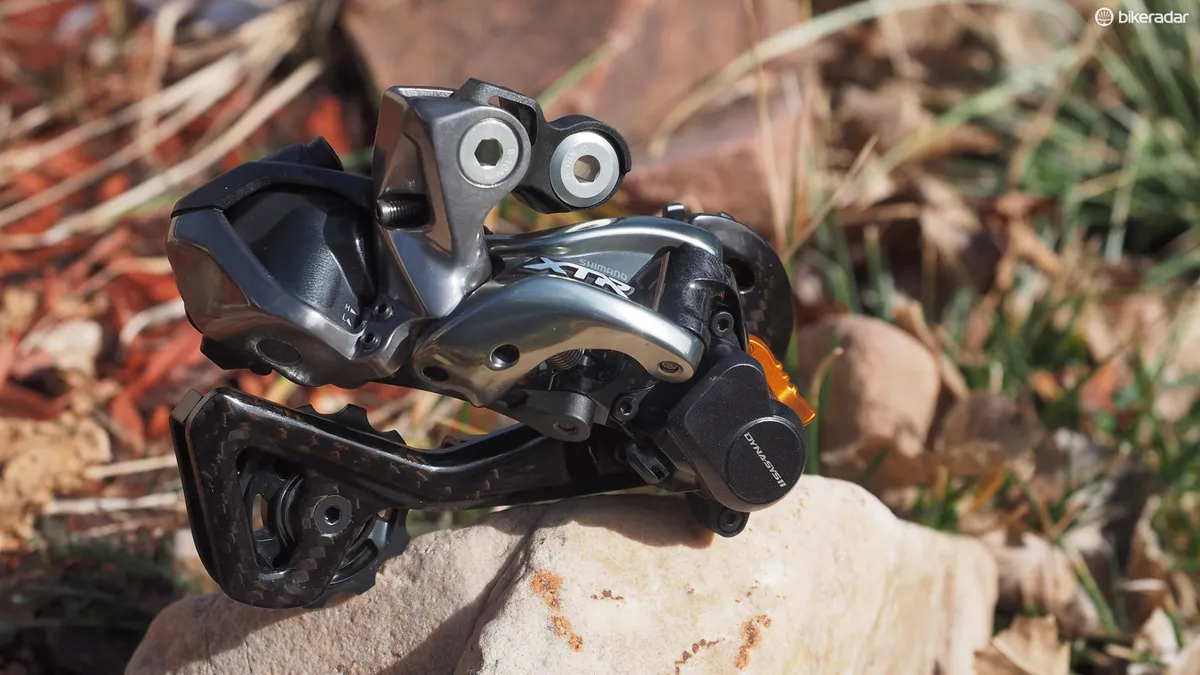
It’s also virtually impossible to find a brand-new XTR M9050 Di2 groupset online or in shops to purchase. Although, when we reviewed it in 2015, the full groupset retailed for £2,499.99.
This all suggests an updated XTR Di2 groupset is imminent and we’re hopeful it’ll provide some tough competition for SRAM’s range-topper.
When pitted against Shimano’s current cable-operated XTR M9100 12-speed drivetrain, which costs £1,125 and weighs 1,547g (just 14g heavier than XX1 Eagle AXS), it’s tricky but not impossible to pick an outright winner.
Arguably, XTR shifts better under power and has – in my opinion – more comfortable to use gear ratios, but it requires cable changes to maintain performance.
When XTR M9100 is in top fettle it feels great and its shifts are as precise as those on XX1 Eagle AXS.
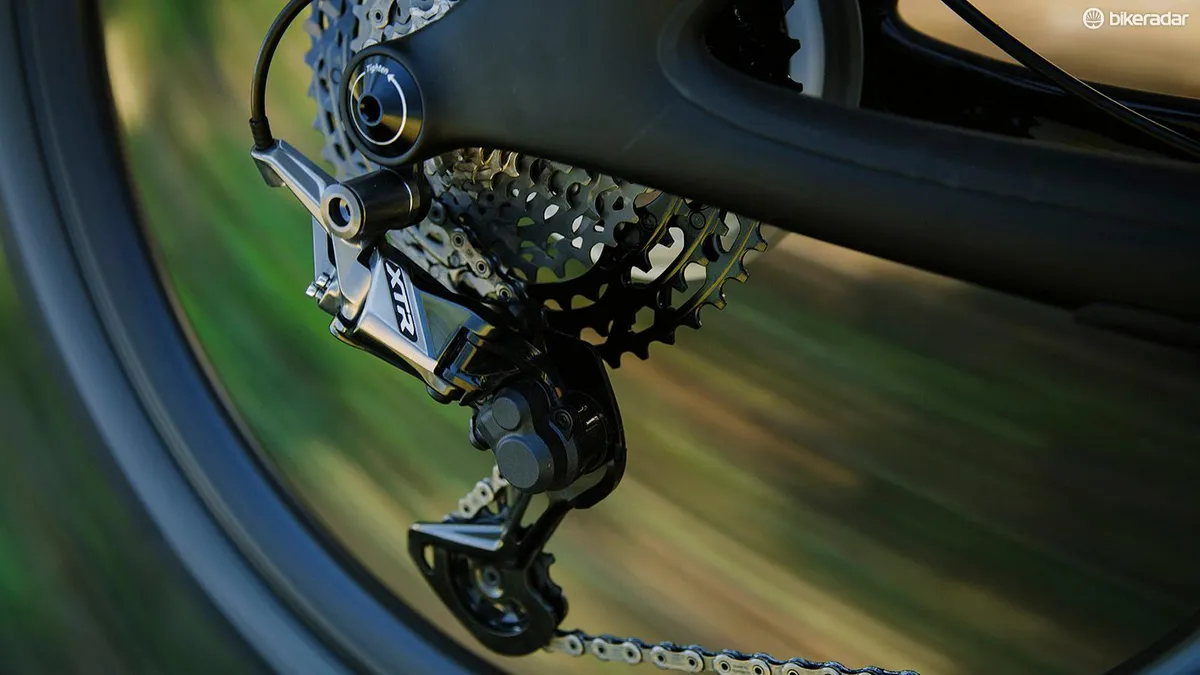
From an installation and maintenance perspective, XX1 AXS trumps XTR M9100, but I’d personally have to find more compelling reasons to justify the additional £833 cost given the weight savings are almost negligible.
This brings me on to GX Eagle AXS, the latest addition to the AXS MTB stable.
Except for the weight (XX1 AXS is 348g lighter), price (XX1 AXS is £1,045 more expensive) and aesthetics (GX is only available in the Lunar colourway), I struggled to find any distinguishable performance differences between GX and XX1.
Shifting is identical, clutch tension is the same and shifter design and functionality are also shared. The main pull of XX1 Eagle AXS, therefore, is its weight and aesthetics.
Arguably, the XX1 Eagle cassette and chain appear to be tougher – although significantly more expensive – than their GX Eagle counterparts.

Although GX Eagle AXS weighs more (334g) than XTR M9100, its lower cost makes it a compelling buy. For people less worried about weight, GX Eagle AXS could well be cannibalising XX1 Eagle AXS sales.
There does appear to be an option that means you can have your cake and eat it by mixing Shimano and SRAM components, especially until Shimano releases an updated XTR Di2 groupset.
‘SRAmano’ or ‘ShimRAM’ aren’t new concepts, but mixing and matching the best bits of each brands’ parts – although not officially sanctioned and actively discouraged by both brands because it could void warranties – could lead to the best performing shifts, easiest to setup and most affordable combination out there.
Given an unlimited budget, I’d fit Shimano’s XTR M9100 cassette, chain, cranks and chainring and match them with SRAM’s XX1 Eagle AXS derailleur and shifter.
All in, that would cost £1,785.96, and tip the scales at 1,633g, 100g heavier than a full XX1 Eagle AXS setup. If you wanted to save that 100g but keep the Shimano cassette and chain, subbing out the Shimano cranks for the XX1 Eagle version would do it.
SRAM XX1 Eagle AXS groupset bottom line
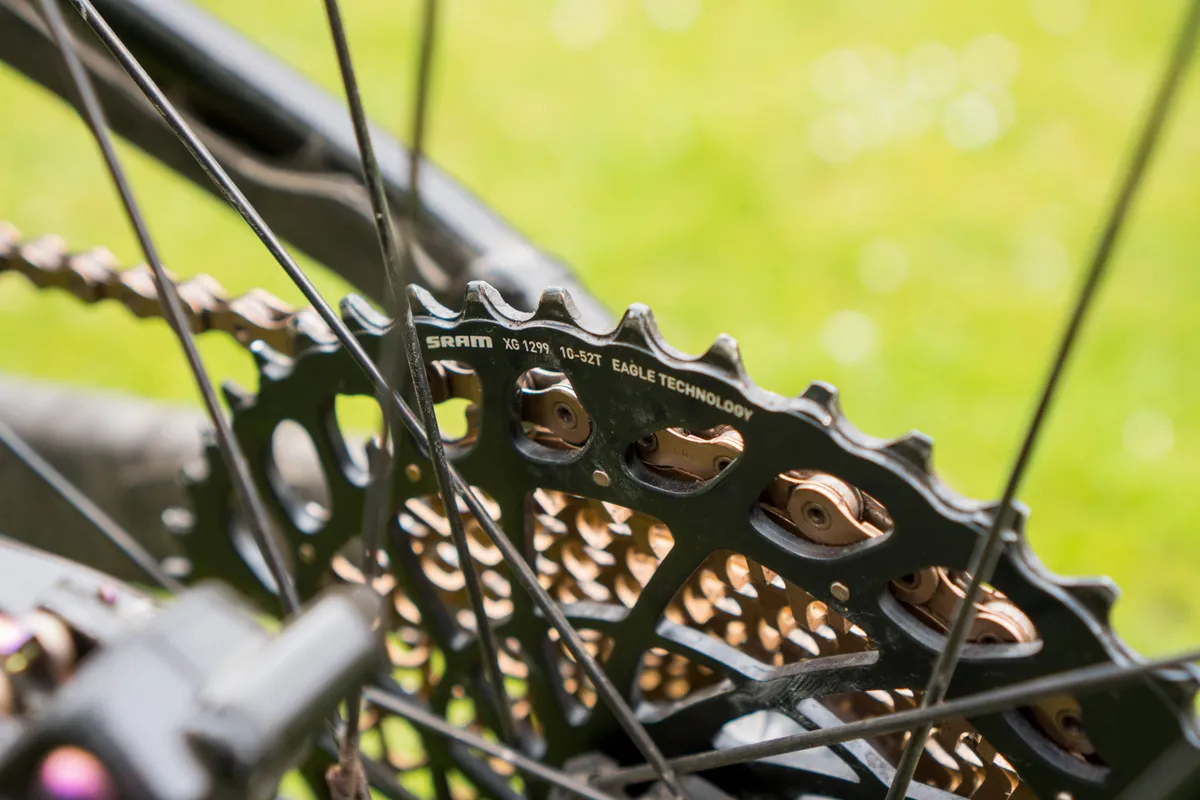
Would I buy SRAM’s XX1 Eagle AXS groupset? In a word, no.
Despite its incredible performance and impressive robustness given its weight, the cost versus benefit ratio isn’t there for me.
That’s not to say it won’t be spot-on for other people, and if you’re looking for the lightest, best performing currently available mainstream wireless, electronic groupset, picking XX1 Eagle AXS is a no brainer.
It’s not without its faults – which are shared across the Eagle ecosystem – but it fulfils its brief immaculately.
GX Eagle AXS does tread on XX1’s toes in terms of performance, and subbing out certain XX1 parts such as the derailleur and shifter for cheaper ones will save some serious cash without huge weight penalties.
For range-topping bikes or super-bling custom builds, it’s hard to not recommend XX1 Eagle AXS, though.
Product
| Brand | Sram |
| Price | A$2783.00, €2168.00, £1958.00, $1949.00 |
| Weight | 1533g |
| br_whatWeTested | SRAM XX1 Eagle AXS |
Features
| Crank options | 1x |
| Speed | 12 |
| Features | DUB, PowerLink, X-Sync 2, Type-3 clutch |
| Cassette options | 10-52, 10-50 |
| Chainring options | 30, 32, 34, 36, 38 |
